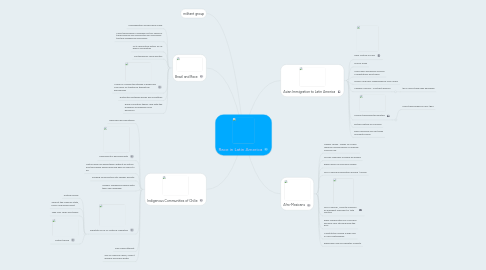Race in Latin America
von Gabrielle Johnson


1. militant group
2. Brazil and Race
2.1. miscegenation solved racial issue
2.2. 2006 the Brazilian Congress met for need for trade schools and universities for individuals that are indigenous individuals
2.3. 2012 affirmative action for all public universities
2.4. contemporary racial politics
2.5. UNESCO conducted studies in Bahia and Sao Paulo on traditional theoretical approaches
2.6. distinction between blacks and mulattoes
2.7. Racial formation theory deal with the problems of Brazilian racial dynamics
3. Indigenous Communities of Chilie
3.1. Mapuche land resistance
3.2. Hydroelectric developments
3.3. Native lands are being taken without an option and the people being removed have no place to go
3.4. Pushing communities into deeper poverty
3.5. Guaraní Indigenous people with their own language
3.6. Zapatista Army of National Liberation
3.6.1. Political group
3.6.2. Against the Mexican state, policy and government
3.6.3. Take over lands and towns
3.6.4. Militant group
3.7. Free Trade attempt
3.8. War on Mexican lands, violent warfare and mass death
4. Asian Immigration to Latin America
4.1. New Castille or Peru
4.2. Manila Trade
4.3. Slave labor produced success of plantations and towns
4.4. Mexico and Peru independence from Spain
4.5. Chinese Coolies - Contract workers
4.5.1. 1874 coolie trade was abolished
4.6. Human trafficking terminated
4.6.1. Slave trade ended in Peru 1854

